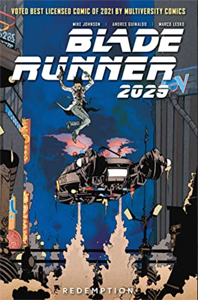In “Do Androids Dream of Electric Sheep,” Philip K. Dick views androids as being distinct from humans because they lack empathy. The “Blade Runner” movie makes the androids (replicants) more sympathetic, but stays true to that aspect of Dick’s premise.
It’s true that both PKD’s novel and Ridley Scott’s film intend – and achieve – irony by illustrating that some replicants are good and some humans are bad. Both book and film show the Voight-Kampff test to be amusingly fallible.
But as I arrive at “Blade Runner 2029: Volume 3 – Redemption” (Issues 9-12, 2022) in my reading of Titan Comics’ continuation from the film, the line is blurry enough to not be a line anymore. It’s more like an amorphous blob.

“Blade Runner 2029” Issues 9-12 (2022)
Subtitle: “Volume 3: Redemption”
Writer: Mike Johnson
Art: Andres Guinaldo
Colors: Mark Lesko
V-K-Verify
“Redemption” starts with hospice worker Ambrose, a cuddly bear of a “people person.” In a parallel to modern USA immigration fears – and more recently and specifically E-Verify, which might someday give the government total control over whether you can get a job – Ambrose’s boss dismisses him over irregularities in his hiring process from back in 2025. Soldiers stand by with guns.
Intriguingly, writer Mike Johnson (again teaming with artist Andres Guinaldo and colorist Mark Lesko, who firmly place us in “BR’s” rainy, neon near-future) has Ambrose decline the V-K test. He opts to depart the job peacefully.
(SPOILERS FOLLOW.)
Later, replicant terrorist leader Yotun gets a blood transfusion from Ambrose, who dies in the process. This suggests Ambrose was perhaps human all along. What began with a clear (if morally superficial) delineation in Dick’s novel is now so fuzzy that a human can assume he’s an android because the government (which could easily mix up its records) says he is.
I suppose the “BR” saga had to get to this point eventually, and I find the irony of the situation delicious. If it’s not what PKD intended narratively, it’s still in the spirit of the author’s penchant for the bizarre and absurd.
‘Blade Runner’ tries ‘Alien’ saga’s puzzle-box approach
That’s a high point of “Redemption.” Meanwhile, the narrative is, well, not a low point, but a middling point. Johnson embarks on a puzzle-box mystery – paralleling Scott’s ventures into that storytelling approach in the “Alien” prequel films of the past decade (“Prometheus” and “Covenant”).
The confirmed (more or less) replicant followers of Yotun likewise fail to recover after giving Yotun transfusions; so perhaps Ambrose was indeed a replicant. And Yotun himself – who has extended his Nexus-6 lifespan via these transfusions — seems to be dying.

This sparks Yotun to track down a box buried in the wildnerness (he knows the location because his artificial memories are Eldon Tyrell’s real memories). The box contains an owl skeleton. The end.
There is stuff to mull over here; for instance, a reader could look up the symbolism of the owl, and go down that rabbit hole. But I find these events too vague for the concluding chapter of “2029,” even though the story continues in “2039.” (Titan says that will be the final installment of good-hearted blade runner Ash’s “2019”-“2029”-“2039” saga.)
A connection with ‘Black Lotus’
Speaking of continuity, “BR” nerds might enjoy seeing Marlowe. He’s the noirishly named blade-runner partner of Ash. She would rather work alone but she has to respect her chief’s orders somewhat, so as not to appear overly suspicious. (She’s secretly helping the Replicant Underground.)
Marlowe is also in TV’s “Blade Runner: Black Lotus,” which takes place in 2032. It’s nice to see the two sagas link up, especially since the comics’ and the TV series’ lead characters are similar enough to be interchangeable in the mind of a casual follower of the saga: Ash here, Elle in “Black Lotus.”
Although both are on the side of replicant rights, one major difference is that Ash is human (although she has an oft-malfunctioning machine spine), whereas Elle is a replicant. Or maybe I should say minor difference.
With “Redemption,” we can now say with some confidence that the “Blade Runner” saga has reached the “singularity” – the point where man and machine are so intertwined as to be essentially the same thing. Of course, humans (and replicants) being who they are, that doesn’t mean peace will reign.

